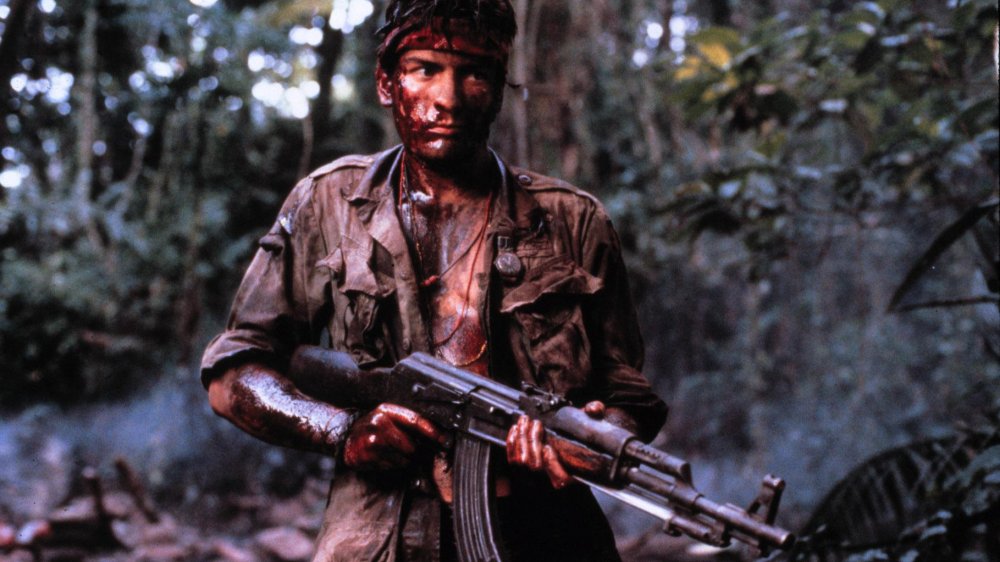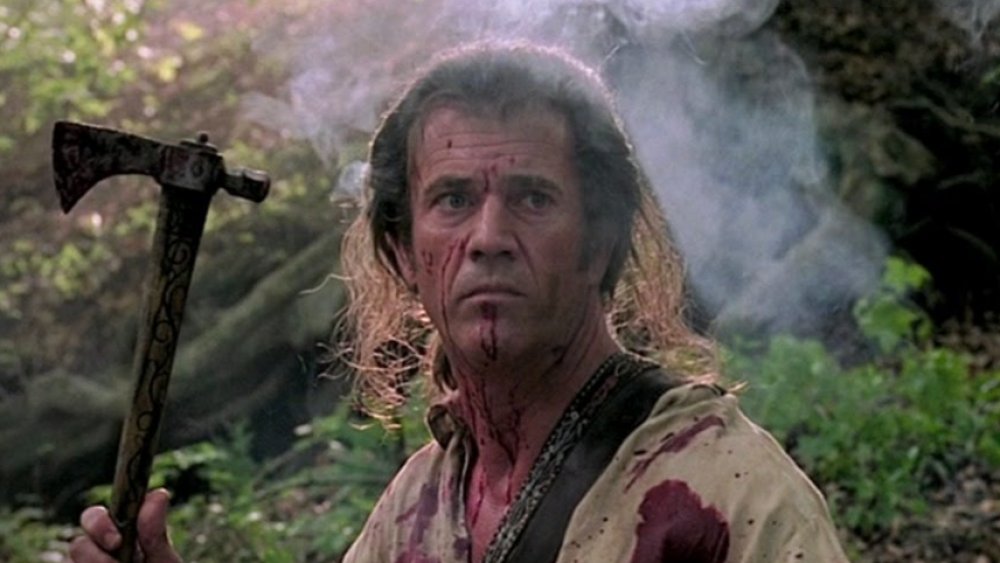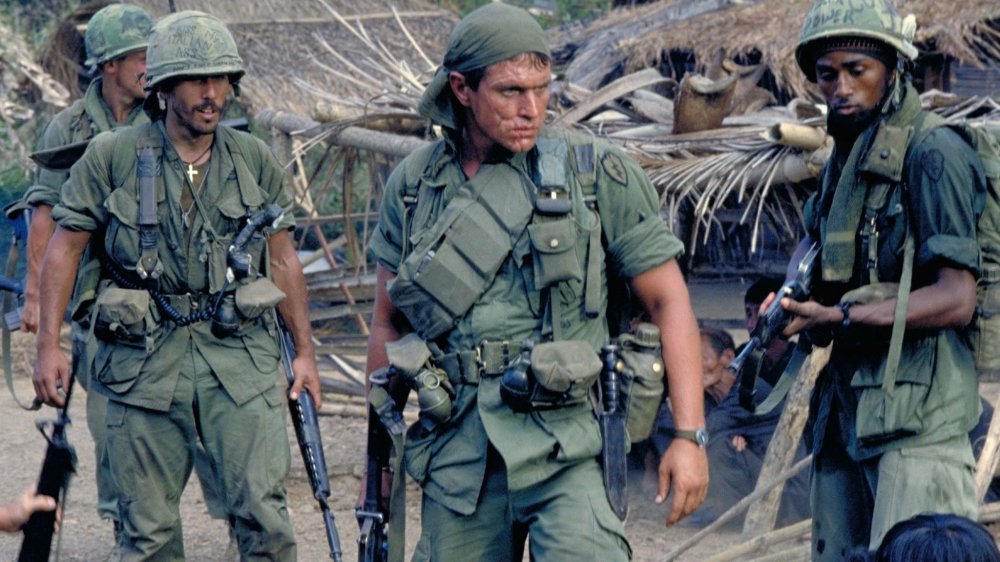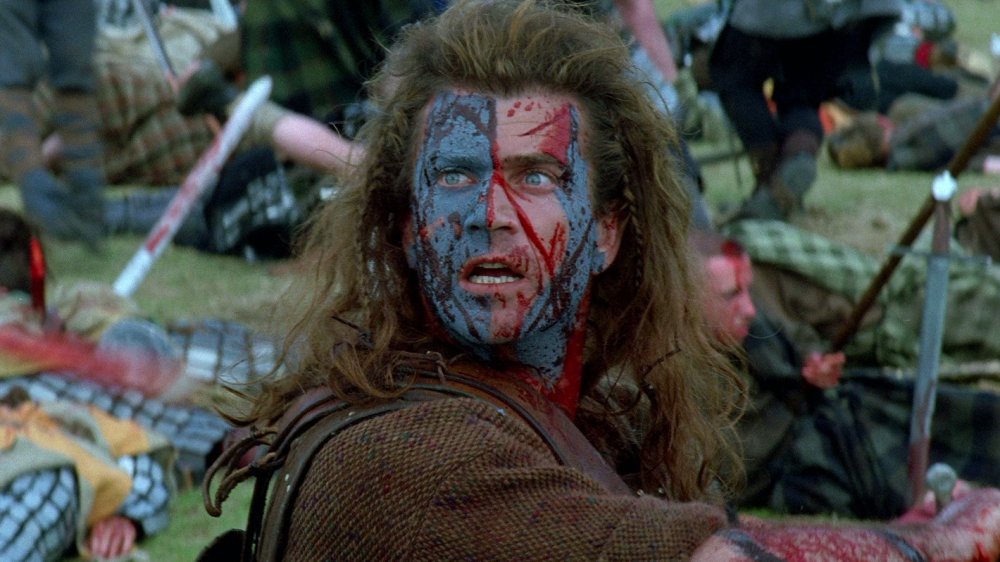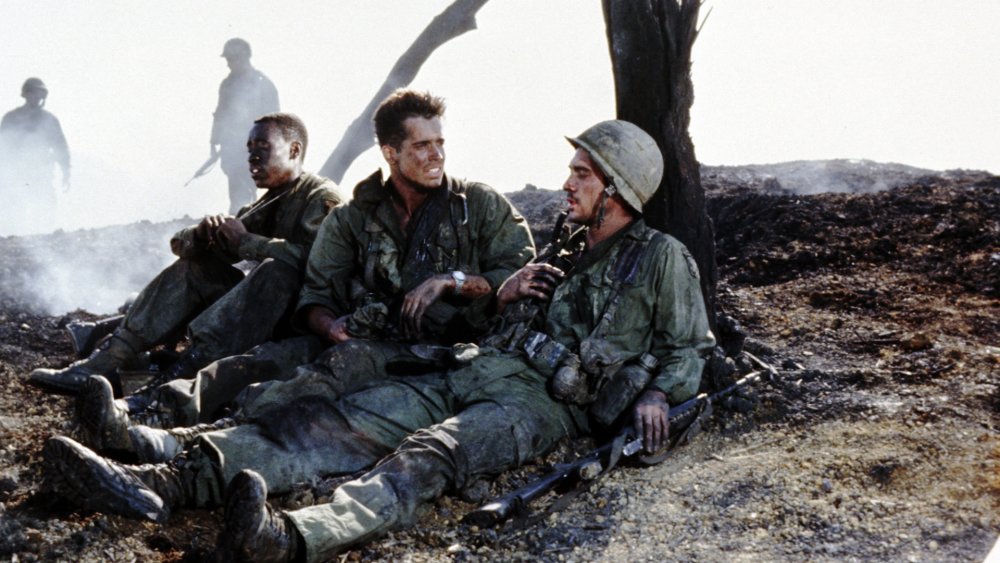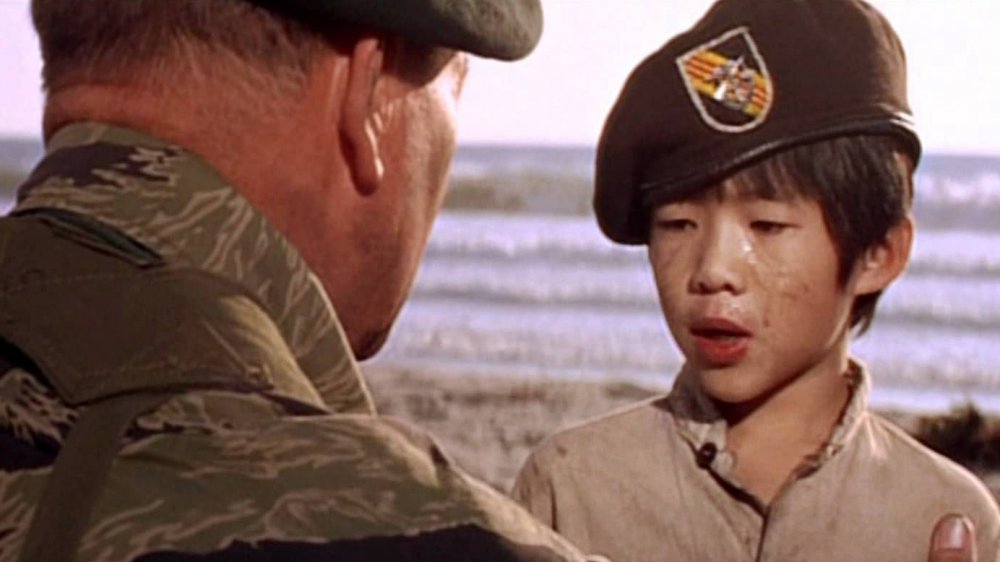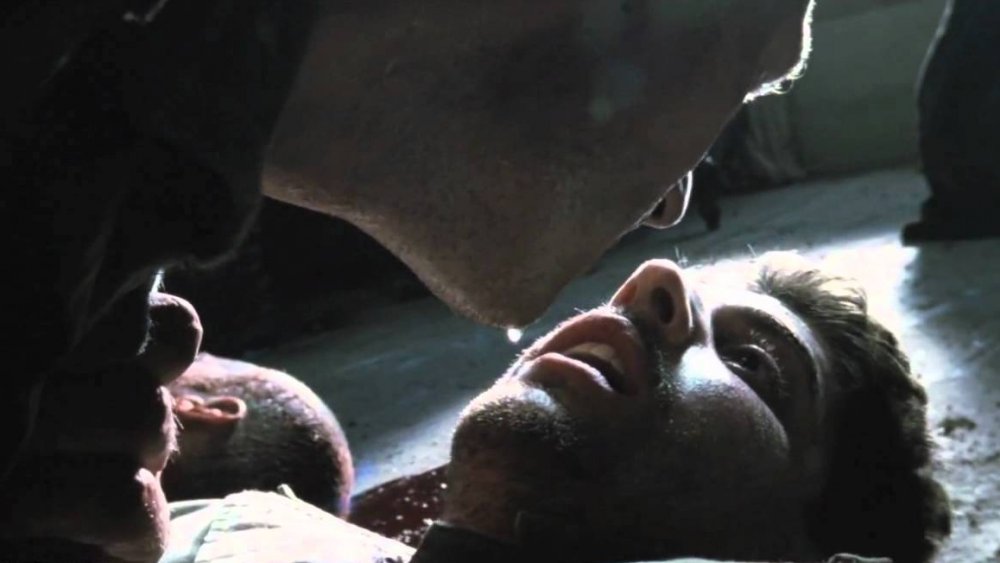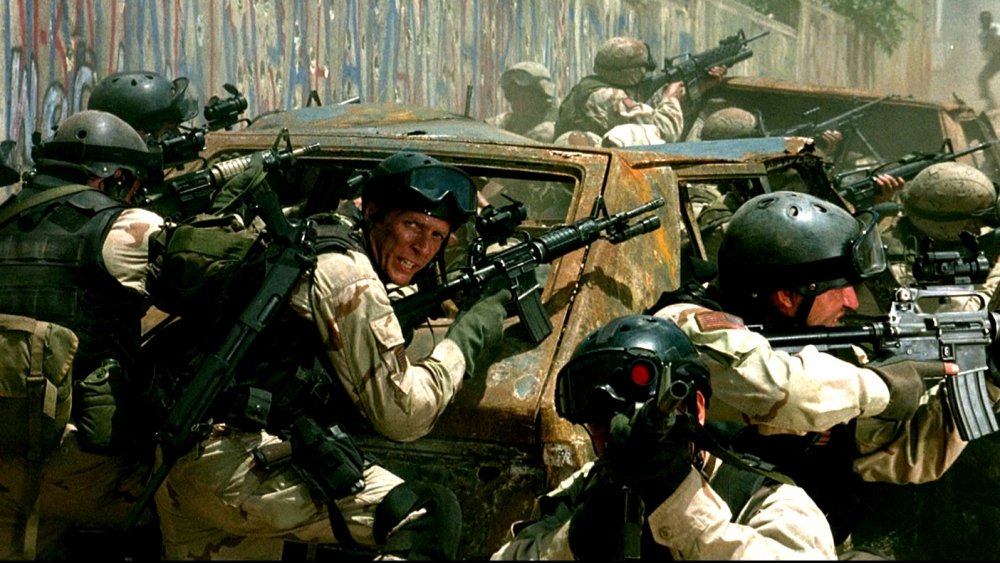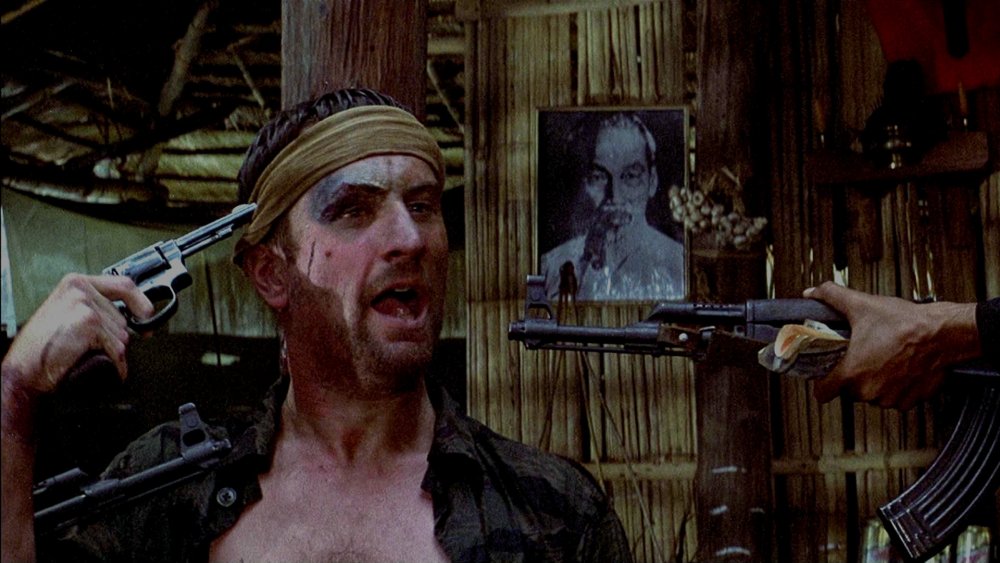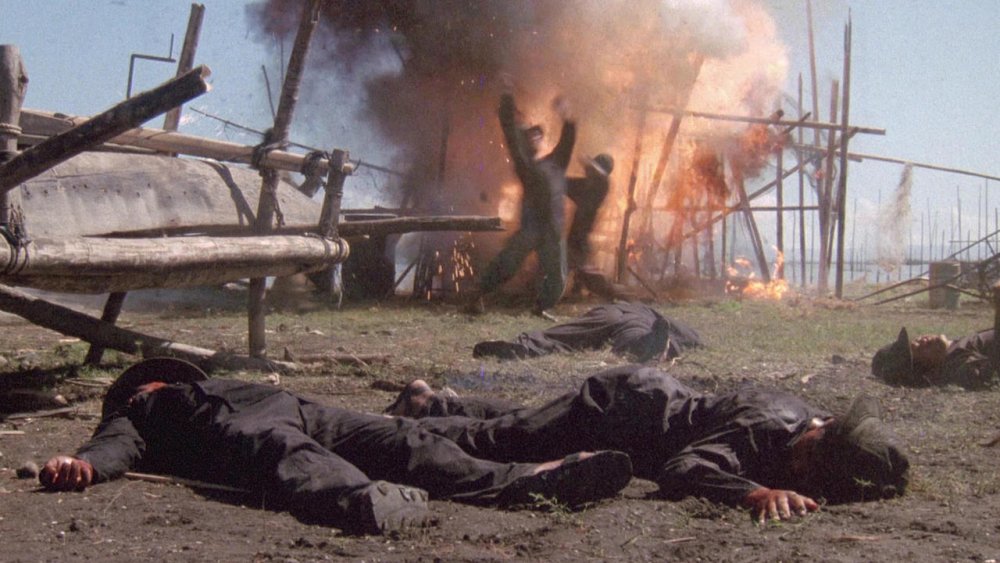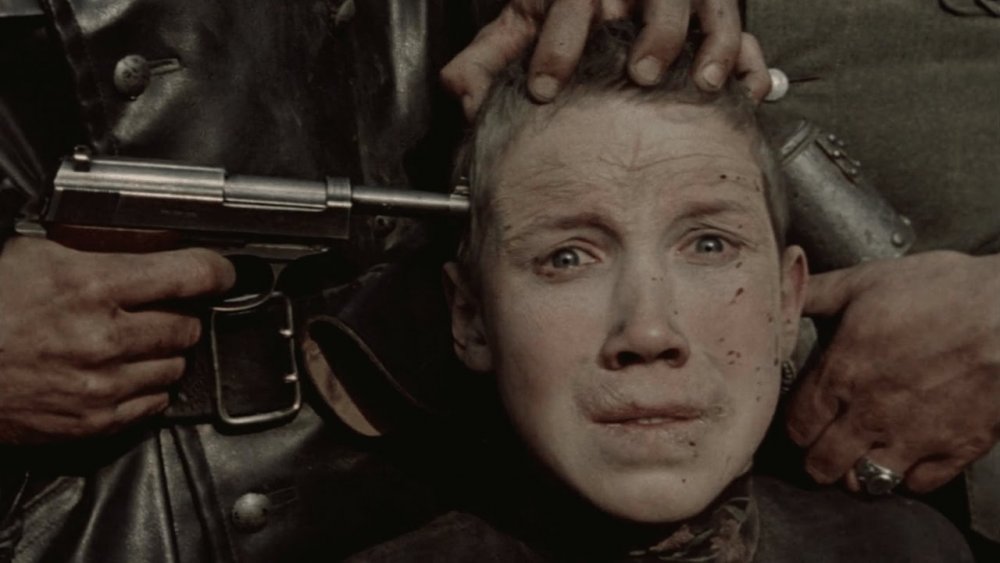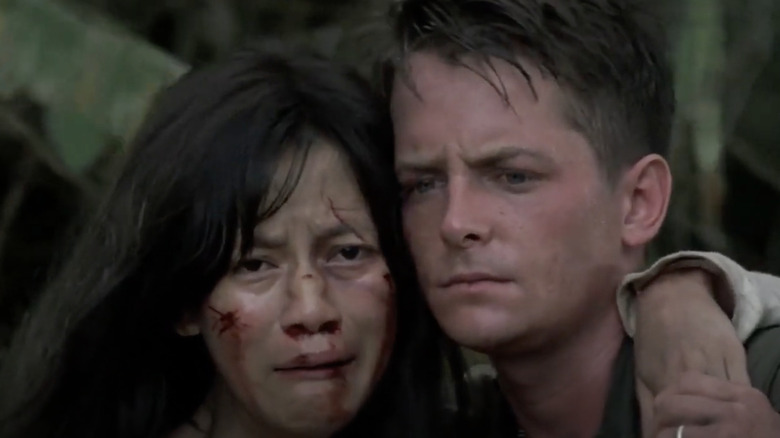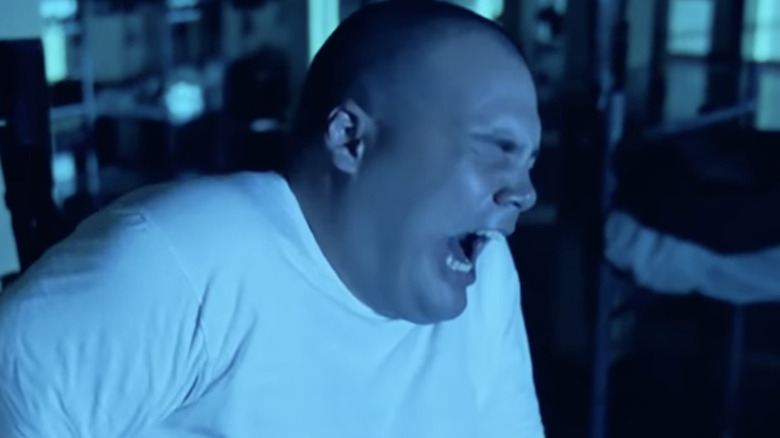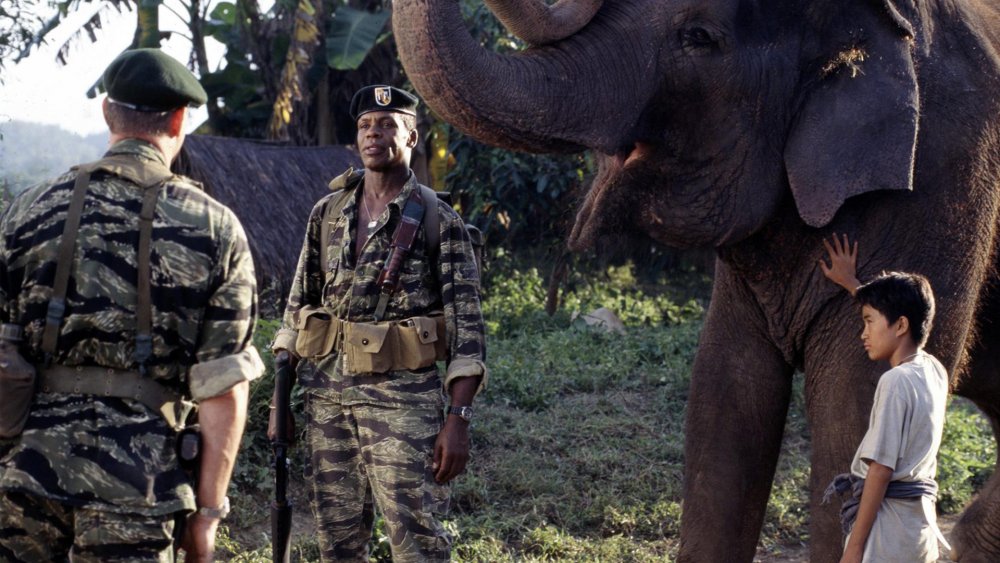War Movie Scenes That Went Too Far
Whatever your opinion of violence in film might be, it's hard to argue that war movies don't offer some form of value to the wider cinematic oeuvre. Sure, explosions and shooting aren't for everyone, but some movies perfectly capture the horrors of war, reminding audiences of the gravity of such conflicts, and hopefully inspiring the moviegoing masses to look at the offscreen realities of armed conflict with a more critical eye.
Sometimes that means getting real, even stomach-churningly so. War is no pretty business, and portraying it accurately can result in films that push the boundaries of what audiences can handle. And then there other war movies that simply don't know when to pull back on the throttle, and as a result end up charging headlong into over-the-top caricature that at best reduces the potential impact of the film, and at worst indulges in the mindless glorification of violence.
To that end, here's a look at some war movie scenes that — for better or worse — went too far.
The Patriot (2000)
When Mel Gibson's Revolutionary War epic "The Patriot" came out at the turn of the millennium, reviews from critics were somewhat mixed, but audiences got so swept up in the action that the buzz seemed to express general satisfaction.
Upon repeat viewings, however, it quickly becomes clear that the presumed gravitas of the movie is undercut by pointlessly gruesome scenes and unnecessary historical inaccuracies. For example, while the British are shown rounding up women and children and burning them alive in a locked church (a scenario that has no basis in reality, at least not from this particular war), something that is never alluded to is the fact that Mel Gibson's heroic lead character Benjamin Martin is based largely on Francis "Swamp Fox" Marian, a southern militia leader who enjoyed killing American Indians and raping slaves.
Perhaps the one scene that best typified the excessive, almost absurd nature of the film comes early on when Martin rescues his eldest son from redcoat arrest. In a matter of moments, he slaughters a dozen soldiers more or less singlehandedly, climaxing in a hatchet-to-the-head toss. This scene is unbelievable, almost comically brutal, and serves no deeper purpose than to thrill viewers who are just in it for the violence.
Platoon (1986)
Some movies on this list will be included because they needlessly went too far, while others went too far with a purpose. "Platoon" falls into the latter category.
Oliver Stone's Vietnam masterpiece was created with the intention of providing audiences with a brutally realistic portrayal in order to show just how horrific that war actually was. And Stone would know — he served in the infantry and was wounded twice, garnering numerous service awards and honors. And his firsthand experience shows.
While the movie isn't short on graphic moments, perhaps the most disturbing comes with his depiction of the My Lai Massacre. It's a grimace-inspiring watch, with acts of rape, general torture and killing, and the character "Bunny" crushing a disabled man's skull with the butt of his rifle for no reason at all. Few scenes in the history of film have so perfectly captured the needless horror of war.
Braveheart (1995)
Mel Gibson has never been one to turn away from making movies that overflow with blood and gore, and while he's not the only actor with a propensity for violent roles, a look through his career seems to show a trend for leaning into movies where the violence offers somewhat questionable value. Thus he makes a second appearance on our list.
While "Braveheart" is an undeniable 1990s classic, not-so-undeniable is the necessity for its substantial bloodletting. Let's put it this way — while cutting out the hyper-realistic violence wouldn't have really taken anything away from the story, including it doesn't really add anything either. In the end, the violence doesn't have much purpose except to make viewers squirm.
The movie's apex of gore comes during its Battle of Stirling scene, in which the English and the Scots face off in a brutal hand-to-hand melee. For nearly four minutes, limbs are severed, skulls are split, and many a belly is run through. And given how famously inaccurate Gibson's telling of William Wallace is, it's questionable whether all the violence added anything to the portrayal.
Hamburger Hill (1987)
The 1980s were packed with movies trying to make sense of the Vietnam War, but few were as realistically gruesome as "Hamburger Hill." And that should come as no surprise as it was directed by John Irvin, a documentarian who spent several years covering the war firsthand.
"Hamburger Hill" tells the true story of the battle for the titular hill — a small piece of high ground in central Vietnam that was given its name due to the number of soldiers who were "ground into hamburger" while trying to capture it. And the movie reflects the relentless brutality that the name implies.
Perhaps the most stomach-churning scene comes at the end when the final battle for the hill leaves few men standing. Head shots abound in gory detail, and in one particularly infamous scene, one man comes staggering out of the smoke like a zombie missing a section of his skull.
The Green Berets (1968)
Helmed by vintage American tough guy John Wayne, "The Green Berets" holds the rare distinction of being a Vietnam War film that supported the conflict. While most movies dealing with that particular war aim to show the horrors and pointless of its events, "The Green Berets" makes an attempt to prop it up as heroic and necessary.
Not that the movie doesn't portray its share of gruesome violence. Perhaps the most memorable instance comes when one of the titular Green Berets becomes snared in an enemy trap and is dragged into a "punji pit" of sharpened bamboo spikes, with predictably bloody results.
But ironically, the scene that garners "The Green Berets'" inclusion in this list isn't one of violence, but one of tenderness. At the end of the movie, John Wayne stands on the beach with a young South Vietnamese boy who he consoles about the death of his father before telling him, "You're what this is all about." Wayne is making a heavy-handed metaphor about the meaning of the war, and the United States' role in protecting its South Vietnamese allies. While the intended sentiment is noble, from a contemporary perspective in which we now realize the realities behind U.S. involvement — not to mention the massive number of civilian casualties — this moment simply doesn't ring true, and will leave most modern viewers rolling their eyes.
Saving Private Ryan (1998)
Steven Spielberg's "Saving Private Ryan" has earned its reputation as one of the most realistic — if not the most realistic — war movies of all time. It's packed from beginning to end with spilled guts, severed limbs, and bullet wounds galore.
So how can "Saving Private Ryan," a movie that was made with the express intention of being as realistic as possible in order to show the brutal nature of war, have gone too far? That was kind of the point, right? "Saving Private Ryan" certainly accomplished this mission — so much so that veterans watching the film were triggered into episodes of PTSD.
With the entire film being relentless in terms of bloody mayhem, it's difficult to choose a specific scene that went over the top, but it's possible to narrow it down to a moment during the final battle in which young Private Mellish, played by Adam Goldberg, is killed in hand-to-hand combat by an enemy soldier who slowly, millimeter by millimeter, plunges a knife into his heart. It has a horribly intimate feeling to it, and it's easy to understand how it would hit too close to home for anyone with actual combat experience.
Black Hawk Down (2001)
A vivid portrayal of a largely forgotten U.S. military venture into civil war-torn Somalia, "Black Hawk Down" received generally positive reviews due to its commitment to accuracy and its highly thrilling, just-try-and-catch-your-breath pace. However, its major failing, as many critics pointed out, revolves around the fact it is all spectacle with nothing much to say. As one critic put it, it's more of an "endurance test" to see if you can wade through all the blood and guts and make it to the credits.
Perhaps the best example of this comes when one soldier is shot in the leg, and a medic is forced to fish around in the wound searching for a severed femoral artery while the unanesthetized soldier writhes in pain. The scene adds little to nothing by the way of storytelling or theme, and in the end it doesn't amount to much more than an extended bout of torture porn.
The Deer Hunter (1978)
One of the most singularly unique films to emerge from the Vietnam War was "The Deer Hunter." Boasting career-defining performances from the likes of Robert De Niro, Christopher Walken, and Meryl Streep, the movie tells the story of how the violence of the war affected a group of friends in small-town America, and depicts the seemingly inescapable nature of PTSD.
Symbolizing this disorder is the game of Russian roulette, which soldiers Vronsky (De Niro) and Chevotarevich (Walken) were forced to play while being held captive by the North Vietnamese. Later, when they've ostensibly escaped the dangers of the war, both men find themselves trapped in circumstances that have them playing the game once again, with Chevotarevich in particular being unable to escape the memories of his suffering. In the climatic scene, the two men face off playing against one another, with Vronsky begging Chevotarevich to bow out. With a final pull of the trigger, Chevotarevich loses in an eruption of blood.
While the scene is certainly gruesome, the difficulty in watching it comes less from the blood and more from the painful performances delivered by Walken and De Niro. It feels real. It feels heartbreaking and genuinely disturbing. Which was, almost certainly, the point.
The Siege of Firebase Gloria (1989)
Whatever your opinion of the Vietnam War happens to be, it's undeniable that many great, illuminating movies came out of it. "The Siege of Firebase Gloria" was not one of them.
Based on the true story of the attempt to protect a remote American base during the infamous Tet Offensive, which was considered a turning point in the war — a turning point that spelled eventual disaster for U.S. forces — "The Siege of Firebase Gloria" stars R. Lee Ermey, whose most famous role was as the ill-fated drill sergeant in "Full Metal Jacket." So far so good, right?
Things go off the rails quickly as the movie descends into a generic shoot-'em-up that doesn't have a whole lot to offer besides machine gun fire and bad special effects. The worst offending scene comes at the end, when Vietnamese forces overwhelm the base in a melee of bad acting, poorly choreographed hand-to-hand fighting, cheesy '80s synth music, and blood squibs, blood squibs, blood squibs.
Come and See (1985)
It should come as no surprise that a Russian film would make it onto this list because, well, it's a country that has undeniably seen its fair share of brutal war.
"Come and See" was directed by Elem Klimov, who was born in Stalingrad — site of one of the greatest military disasters in all of history — a battle from which he just barely escaped. This experience would later inform the realism and anti-war nature of his work.
With a focus on the Nazi occupation of Belarus, "Come and See" famously depicts the horrors of war in painfully brutal detail. In a movie so packed with violence and devastation, it's hard to pick out a single troublesome scene. But arguably the most jarring moment comes near the end, when the Nazis have rounded up a village full of people, locked them in a church, then set it ablaze (which was based upon a real-life incident). One young woman escapes, only to be gang-raped and beaten by the Nazi attackers. She closes out the movie with blood pouring down her legs, her face bloodied and bruised.
It's a difficult watch, to say the least.
Casualties of War (1989)
By the late '80s, audiences were used to seeing Michael J. Fox as charming guys in comedies, like Alex P. Keaton on "Family Ties" and Marty McFly in "Back to the Future." In 1988, he flexed some dramatic muscle and was cast against type in the tough-to-watch "Casualties of War," part of a spate of Hollywood films examining the horrors of the Vietnam War a decade removed from the American military's participation in that conflict.
Far from a tale of combat heroism and bravery, "Casualties of War," based on a true story, is an unflinching indictment and admonition of the reprehensible behavior of a handful of soldiers. Fox plays Eriksson, a young and naive infantryman stationed to a unit full of grizzled veterans, led by Meserve (Sean Penn), a sergeant mentally and morally broken by war. After he's prevented from seeking out the services of a sex worker, Meserve reacts by sneaking into a village and kidnapping a young woman named Oanh (Thuy Thu Le) to service his own physical needs and those of his men, repeatedly and against her will. Fox's character serves as the voice of reason, refusing to participate in the group assault, for which he's ostracized and dressed down by Meserve. Then viewers get to see four soldiers violently and horrifically brutalize the kidnapped woman before shooting and murdering her.
Full Metal Jacket (1987)
It's probably to be expected that Stanley Kubrick, the filmmaker responsible for some of the most indelible moments in movie history — from the cosmic beauty of "2001: A Space Odyssey" to the disgusting "ultra-violence" of "A Clockwork Orange" — would make a war movie that's utterly unrelenting in its intensity, realism, and shocking violence, all serving to highlight man's darkness and explosive inhumanity.
While the second half of "Full Metal Jacket" includes some of the most visceral and realistic combat scenes ever committed to film, the first part depicts the basic training of a platoon of American troops fighting in the Vietnam War. The weakest and most ill-prepared among them is Private Pyle (Vincent D'Onofrio), out of shape and lacking a warrior mentality. His fellow soldiers take it upon themselves to make Private Pyle get better, in the form of violently hazing him. For a long and deliberate two minutes, Kubrick trains the camera on Pyle as a seemingly endless parade of soldiers, one after another, savagely beats the man, gagged and tied down to his bunk in the middle of the night, with bars of soap wrapped in towels. His screams and yelps of surprise, fear, and terror only make it more difficult for the viewer to endure.
Operation Dumbo Drop (1995)
Now for something entirely different, we're going to close out the list with a movie that went too far in terms of its lighthearted stupidity.
Disney — yes, Disney — decided that they wanted to make a Vietnam War film. Not only that, but they elected to make a Vietnam War film that was a family-friendly comedy. What could go wrong?
The result was "Operation Dumbo Drop," a confusing muddle of a movie about a Green Beret unit that is tasked with finding and delivering an elephant. For some reason. Regardless of the fact that it is supposedly based upon real events, it's difficult to overemphasize how dumb this whole concept really is. The movie was greeted with an abysmal a 31% critic score on Rotten Tomatoes, and did even worse with the audience, who gave it just 29%.
In a movie this bad, it's really hard to pick out just one scene where things went wrong. So let's go ahead and just put it this way: the entire mess went too far, plunging deep into the depths of folly.
Stay in your lane, Disney. War isn't a topic that needs the Mouse's treatment.
